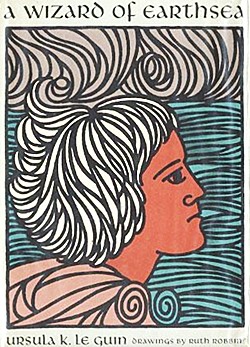
A Wizard of Earthsea is a fantasy novel written by American author Ursula K. Le Guin and first published by the small press Parnassus in 1968. It is regarded as a classic of children's literature and of fantasy, within which it is widely influential. The story is set in the fictional archipelago of Earthsea and centers on a young mage named Ged, born in a village on the island of Gont. He displays great power while still a boy and joins a school of wizardry, where his prickly nature drives him into conflict with a fellow student. During a magical duel, Ged's spell goes awry and releases a shadow creature that attacks him. The novel follows Ged's journey as he seeks to be free of the creature.

Ursula Kroeber Le Guin was an American author. She is best known for her works of speculative fiction, including science fiction works set in her Hainish universe, and the Earthsea fantasy series. Her work was first published in 1959, and her literary career spanned nearly sixty years, producing more than twenty novels and over a hundred short stories, in addition to poetry, literary criticism, translations, and children's books. Frequently described as an author of science fiction, Le Guin has also been called a "major voice in American Letters". Le Guin said she would prefer to be known as an "American novelist".
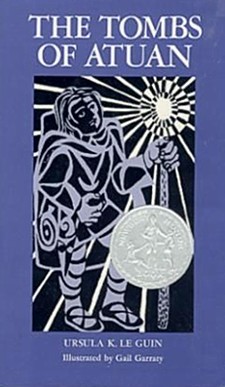
The Tombs of Atuan is a fantasy novel by the American author Ursula K. Le Guin, first published in the Winter 1970 issue of Worlds of Fantasy, and published as a book by Atheneum Books in 1971. It is the second book in the Earthsea series after A Wizard of Earthsea (1969). The Tombs of Atuan was a Newbery Honor Book in 1972.

The Earthsea Cycle, also known as Earthsea, is a series of high fantasy books written by the American author Ursula K. Le Guin. Beginning with A Wizard of Earthsea (1968), The Tombs of Atuan, (1970) and The Farthest Shore (1972), the series was continued in Tehanu (1990), and Tales from Earthsea and The Other Wind. In 2018, all the novels and short stories were published in a single volume, The Books of Earthsea: The Complete Illustrated Edition, with artwork by Charles Vess.
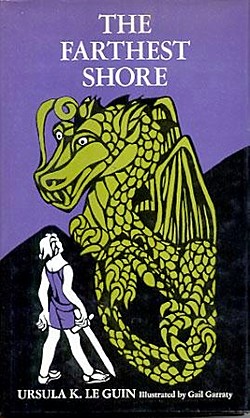
The Farthest Shore is a fantasy novel by the American author Ursula K. Le Guin, first published by Atheneum in 1972. It is the third book in the series commonly called the Earthsea Cycle. As the next Earthsea novel, Tehanu, would not be released until 1990, The Farthest Shore is sometimes referred to as the final book in the so-called Earthsea trilogy, beginning with A Wizard of Earthsea. The events of The Farthest Shore take place several decades after The Tombs of Atuan and continue the story of the wizard Ged.

The Other Wind is a fantasy novel by the American author Ursula K. Le Guin, published by Harcourt in 2001. It is the fifth and final novel set in the fictional archipelago Earthsea. It won the annual World Fantasy Award for Best Novel and was runner up for the Locus Award, Best Fantasy Novel, among other nominations.

Tehanu, initially subtitled The Last Book of Earthsea, is a fantasy novel by the American author Ursula K. Le Guin, published by Atheneum in 1990. It is the fourth novel set in the fictional archipelago Earthsea, following almost twenty years after the first three Earthsea novels (1968–1972), and not the last, despite its subtitle. It won the annual Nebula Award for Best Novel and the Locus Award for Best Fantasy Novel.

Tales from Earthsea is a collection of fantasy stories and essays by American author Ursula K. Le Guin, published by Harcourt in 2001. It serves as an accompaniment to the five novels of the Earthsea cycle, all set in the fictional archipelago Earthsea.
"The Word of Unbinding" is a short story by American writer Ursula K. Le Guin, first published in the January 1964 issue of Fantastic, and reprinted in collections such as The Wind's Twelve Quarters. In this story, the Earthsea realm, later made setting of the novel A Wizard of Earthsea, was first introduced. Along with the story "The Rule of Names", this story conveys Le Guin's initial concepts for the Earthsea realm, including its places and physical manifestation, but not the characters appearing in the novels.

The Wind's Twelve Quarters is a collection of short stories by American writer Ursula K. Le Guin, named after a line from A. E. Housman's A Shropshire Lad, and first published by Harper & Row in 1975. A retrospective of Le Guin's short stories, it collects 17 previously published pieces of speculative fiction. Four of these were the germs of novels she was to write later, and a few others shared connections to Le Guin novels. At least four stories are set in the Hainish Universe, and two others in Earthsea. Many stories share themes and motifs, including time and utopia: certain images and characters also recur, including isolated scholars or explorers seeking knowledge in a hostile world.
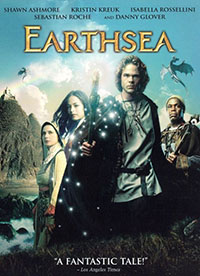
Legend of Earthsea is a two-part television fantasy miniseries produced for the Sci-Fi Channel and aired in 2004. It is an adaptation of the Earthsea novels by Ursula K. Le Guin. The teleplay was written by Gavin Scott, and the series was directed by Robert Lieberman. Legend of Earthsea is an American-Canadian co-production that was filmed on location in Vancouver, British Columbia.
A true name is a name of a thing or being that expresses, or is somehow identical to, its true nature. The notion that language, or some specific sacred language, refers to things by their true names has been central to philosophical study as well as various traditions of magic, religious invocation and mysticism (mantras) since antiquity.
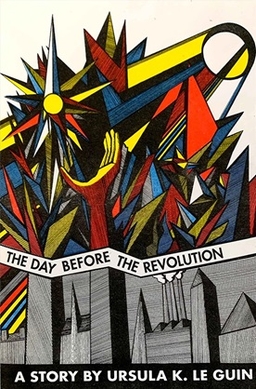
"The Day Before the Revolution" is a science fiction short story by American writer Ursula K. Le Guin. First published in the science fiction magazine Galaxy in August 1974, it was anthologized in Le Guin's 1975 collection The Wind's Twelve Quarters and in several subsequent collections. Set in Le Guin's fictional Hainish universe, the story has strong connections to her novel The Dispossessed, and is sometimes referred to as a prologue to the longer work, though it was written later.
"Winter's King" is a science fiction short story by American writer Ursula K. Le Guin, originally published in the September 1969 issue of Orbit, a fiction anthology. The story is part of the Hainish Cycle and explores topics such as the effects on humans of space travel at nearly the speed of light, as well as religious and political topics such as feudalism.

Ursula K. Le Guin (1929–2018) was an American author of speculative fiction, realistic fiction, non-fiction, screenplays, librettos, essays, poetry, speeches, translations, literary critiques, chapbooks, and children's fiction. She was primarily known for her works of speculative fiction. These include works set in the fictional world of Earthsea, stories in the Hainish Cycle, and standalone novels and short stories. Though frequently referred to as an author of science fiction, critics have described her work as being difficult to classify.
Ged is the true name of a fictional character in Ursula K. Le Guin's Earthsea realm. He is introduced in A Wizard of Earthsea, and plays both main and supporting roles in the subsequent Earthsea novels. In most of the Earthsea books he goes by the Hardic name Sparrowhawk; as a child he is known as Duny.
Earthsea is a fictional world created by American writer Ursula K. Le Guin. Introduced in her short story "The Word of Unbinding", published in 1964, Earthsea became the setting for a further six books, beginning with A Wizard of Earthsea, first published in 1968, and continuing with The Tombs of Atuan, The Farthest Shore, Tehanu, Tales from Earthsea and The Other Wind. Nine short stories by Le Guin are also set in Earthsea; the earliest two in her 1975 collection of short stories The Wind's Twelve Quarters, five in Tales from Earthsea, and the final two in an illustrated collection in The Books of Earthsea. Collectively, the series is simply known as Earthsea.
"Vaster than Empires and More Slow" is a science fiction story by American author Ursula K. Le Guin, first published in the collection New Dimensions 1, edited by Robert Silverberg. It is set in the fictional Hainish universe, where Earth is a member of an interstellar "League of Worlds". The anthology was released in United States in 1971, by Doubleday Books.
The Books of Earthsea is a collection of fantasy fiction and commentary by American author Ursula K. Le Guin, published by Saga Press in 2018 on the 50th anniversary of the publication of the first book of the series, A Wizard of Earthsea. It includes a new introduction, the five Earthsea novels along with afterwords written in 2012, and short stories set in the Earthsea world. It is illustrated by Charles Vess.










